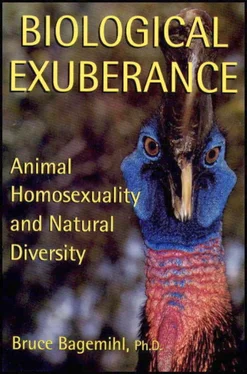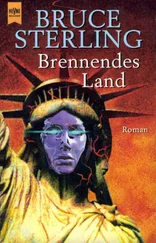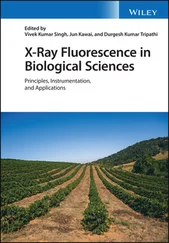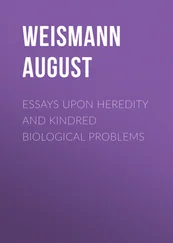As these examples show, not only are transgendered and genderless biologies a fact of life for many animals, they have developed into incredibly sophisticated and complex systems of social organization and behavioral patterning in many species. For those of us used to thinking in terms of two unchanging and wholly separate sexes, this is extraordinary news indeed. Likewise, animal homosexuality itself is a rich and multifaceted phenomenon that is at least as complex and varied as heterosexuality Animals of the same sex court each other with an assortment of special—and in some cases, unique—behavior patterns. They are both affectionate and sexual toward one another, utilizing multiple forms of touch and sexual technique, ranging from kissing and grooming to cunnilingus and anal intercourse. And they form pair-bonds of several different types and durations and even raise young in an assortment of same-sex family configurations. If, as scientist J. B. S. Haldane stated, the natural world is queerer than we can ever know, then it is also true that the lives of “queer” animals are far more diverse than we could ever have imagined. In the next chapter, we’ll take a look at how these different forms of sexual and gender expression in animals compare to similar phenomena in people.
Chapter 2
Humanistic Animals, Animalistic Humans
Titus and Ahab—male Gorillas—often courted and had sex with one another in the mountains of Rwanda, while Marchessa sought out her own sex during her pregnancy. In Florida, Bottlenose Dolphins Frank, Floyd, and Algie participated in homosexual activity with each other, as did Gabe and Moe-Miller, West Indian Manatees. Les and Sam (Siamangs) were doing the same in Milwaukee, while Kiku, a female Bonobo living in Congo (Zaire), had sex with her female “mentor” Halu more often than with anyone else in the new troop she joined. Cato and Mola (male Crested Black Macaques), Depp and Nice (male Rhesus Macaques), as well as Saruta and Oro (male Japanese Macaques) and Daddy and Jimmy (Crab-eating Macaques), also mounted one another. On the isle of Corsica, Le Baron and Le Valet (Asiatic Mouflons) were inseparable, as were Marian and her female Grizzly companion in the high mountains of Wyoming. Apolli and Arima—Long-eared Hedgehogs in Vienna—each refused to mate with males after they were separated from one another. In Austria, Greylag gander Pepino had a brief liaison with Florian but was later courted by Serge, while Max, Odysseus, and Kopfschlitz formed a threesome and went on to raise a family with Martina. A White-handed Gibbon named Floyd became sexually involved with George (his father) in Thailand, while Sibujong and Bobo, male Orang-utans, had sexual interactions with one another in Indonesia. 1
As these examples show, zoologists sometimes bestow names upon the animals they study, lending an unintentionally—and eerily—human quality to their reports of homosexual activity. Although most scientists are careful to avoid anthropomorphizing their subjects, their use of human names such as these reminds us at once of each creature’s individuality as well as the dangers of projecting human qualities onto animals. Such naming also demonstrates the nearly universal human preoccupation with seeking connections between ourselves and other species. Where animal behavior—especially sexual behavior—is concerned, it seems that comparisons will inevitably be made between animals and people (even by scientists).
There are a number of genuine connections and points of correspondence between animal and human homosexuality, as well as significant differences. There are also numerous pitfalls in attempting to extrapolate from animal to human behavior, or vice versa. This chapter explores a number of specific animal-human comparisons and the issues surrounding them. For example, we’ll address claims that certain aspects of homosexuality are uniquely human, such as various types of sexual orientation, or the treatment of homosexual and transgendered individuals in the larger society. Also to be discussed are the special insights into human behavior offered by primate homosexuality (especially cultural behavior), and the rationale and motivations behind making cross-species comparisons in the first place (especially where the dubious concept of “naturalness” is concerned). Overall, a cautionary note must be sounded: while it is tempting to jump to broad conclusions about human homosexuality based on animal behavior (or vice versa), the full complexity and richness of homosexual expression in both animals and people must be considered. Only then will we begin to understand both the uniqueness and the commonalities of each.
From Pederasty to Butch-Femme: Uniquely Human?
One of the most significant results to emerge from the study of human homosexuality over the past few decades is the enormous variety of forms that this activity takes. From pederasty or “boy love” in ancient Greece, to ritualized homosexual initiation in New Guinea, to butch-femme lesbian relationships, to situational homosexuality in prisons, to contemporary North American gay couples—homosexuality has assumed many guises across history, cultures, and social situations. Thus, while homosexual desires and activities are probably ubiquitous, the specific forms that they assume are intimately shaped by particular sociohistorical contexts. Instead of talking about homosexuality, we should really speak in terms of homosexualities , plural, for there are many variations on the theme of same-sex relations. 2
Animal homosexuality puts a new twist on this observation, since nearly every type of same-sex activity found among humans has its counterpart in the animal kingdom. Comparisons between animal and human homosexuality are inevitably muddled, however, by the lack of an adequate understanding and classification of different types of homosexuality. The confusion surrounding this subject is readily apparent: activities as different as pair-bonding between female Kangaroos and same-sex mounting in male Bighorn Sheep and Bottlenose Dolphins, for example, have all been compared to the sort of homosexual activity that occurs among human beings in prisons. 3The problem with analogies like this—which are inevitably imperfect and inaccurate—is that something like “prison homosexuality” is itself actually a conflation of many different behavioral variables and diverse patterns of same-sex activity, as are the “corresponding” animal behaviors. 4In addition to the actual form of the homosexual activity involved (pair-bonding, sexual behavior, etc.), many other factors must be considered, such as consensuality, age, gender presentation of partners, and so on. Thus, a particular example of homosexual activity—whether animal or human—is in reality a unique amalgamation or “blend” of multiple factors, any one of which may be shared with other forms of homosexual activity without necessarily conferring identity between the overall patterns they represent. Comparisons of homosexuality in animals and humans that fail to recognize such complexities are simply misleading.
It is helpful in this regard to think of homosexuality in terms of a number of independent axes, each of which is a continuum joining two “opposite” ends of a particular category (as suggested by researchers Stephen Donaldson and Wayne Dynes, who have developed a typology for human homosexuality based on this framework). 5For example, one axis might represent the degree to which the homosexual interaction is gendered or role-based (ranging from the heavily role-oriented homosexuality of Native American two-spirits or Euro-American butch-femme lesbians, to the nongendered homosexuality of the South African San peoples or some gay couples in contemporary Euro-American culture). Another axis would represent the age relationship of the partners involved (ranging from no age difference to a clearly age-differentiated interaction); another represents sexual orientation of participants (homosexual ↔ bisexual ↔ heterosexual); another consensuality (forced or nonconsensual ↔ freely chosen or consensual); another genetic relatedness of partners (incestuous ↔ unrelated); another social status or position of same-sex activity (socially sanctioned ↔ socially condemned); and so on.
Читать дальше












